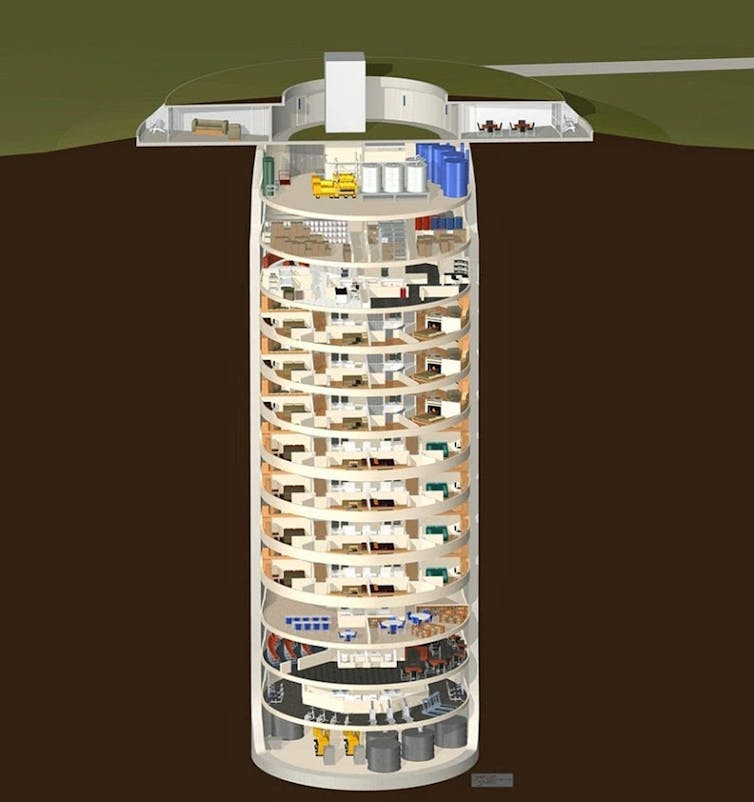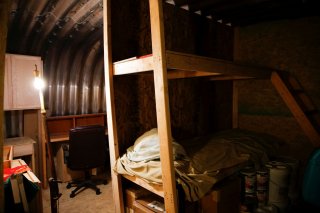How Coronavirus Is a "Mid-Level Event" for Those With Bunkers
They are preparing for doomsday.
Nestled among Kansas cornfields in a landscape devoid of any noticeable natural topography, a verdant mound can be seen from a dirt road. Surrounded by a military-grade chain fence and in the shadow of a large wind turbine, a security guard in camouflage paces the fence line with an assault rifle. If you look closely, you might notice what looks like a concrete pill box perched on the top of the small hill, flanked by cameras. What lies underneath is a bunker that is unassuming, unassailable and – to many – unbelievable.
To the outsider it looks a bit like a secret government installation – and indeed at one time it was. But this is not a bunker built to hide citizens or to protect the politicians who ordered its construction. It is an Atlas F missile silo, built by the US in the early 1960s at a cost of about US$15 million. It was one of 72 blast “hardened” silo structures built to protect nuclear-tipped Intercontinental Ballistic Missiles with an ordnance 100 times more powerful than the bomb dropped on Nagasaki. Although it was out of sight and out of mind to the average US citizen, it played a crucial role in a geopolitical agenda of extinction-level significance during the Cold War.
However, that was then. The bunker is now no longer owned by the government, but by Larry Hall, a former government contractor, property developer and self-confessed doomsday “prepper” who purchased it in 2008. Preppers are the people who anticipate and attempt to adapt for what they see as probable or inevitable and impending conditions of calamity (ranging from low-level crises to extinction-level events). According to Michael Mills, a criminologist at the University of Kent, preppers build for situations where “food and basic utilities may be unavailable, government assistance may be non-existent and survivors may have to individually sustain their own survival”.
Since purchasing the silo over a decade ago, Hall has transformed this subterranean megastructure into a 15-story inverted tower block – a “geoscraper” – now dubbed Survival Condo. It is designed for a community of up to 75 people to weather a maximum of five years inside a sealed, self-sufficient luxury habitat. When the event passes, residents expect to be able emerge into the post-apocalyptic world (PAW, in prepper parlance) to rebuild society afresh.
I spent three years conducting ethnographic research with nearly 100 preppers from six countries, including Australia, the UK, Germany, Thailand, Korea and the US. I’ve hung out in bunker complexes on the Great Plains, with groups growing food in secret forests, with people building heavily armored vehicles, and with religious communities that have collected supplies that they’re ready to hand over to strangers in need. According to these preppers, the ongoing COVID-19 pandemic is merely a “mid-level” event – a warm up for what is to come. They anticipated and prepared for a disaster just like this one, and – unlike most of us – say they weren’t caught by surprise.
Most preppers are not in fact preparing for doomsday – they’re everyday people who anticipate and try to adapt for many conditions of calamity; conditions which they believe inevitable and have been exponentially escalated through human hubris and excessive reliance on technology and global trade networks. While the disasters they anticipate might – at the more extreme end of the spectrum – include major “resets” like an all-out nuclear war or a massive electromagnetic pulse from the sun that would fry our fragile electronics, most preppers stockpile for low to mid-level crises like the one the world is experiencing now.
Indeed, a new banner on Survival Condo’s website boasts that the silo’s nuclear, biological and chemical air filters can “screen out” the COVID-19 virus. While most of us wouldn’t build against crisis to this degree, or even get the opportunity to, there are still some lessons I discovered that society can learn from preppers and the way they look at the world.
A brief history of survivalism
Prior to prepping there was survivalism, a Cold War-era practice focused on practical approaches to potential cultural and environmental disasters. One of the primary concerns of survivalists was the possibility of nuclear war. This was a threat which they felt was brought about by scientists, elites and politicians willing to sacrifice citizens in the name of geopolitics. Many survivalists, as a result, were distrustful of heavy-handed government and globalisation – they often dodged taxes and the law while relying heavily on the perceived autonomy enshrined by the US constitution.
Kurt Saxon, the man who coined the term survivalism, advocated for armed revolution and wrote primers on how to create improvised weapons and munitions. Some survivalists, following his lead, became radicalised as they worked to cultivate self-sufficiency by breaking away from government oversight. Both Timothy McVeigh, the Oklahoma City Bomber, and David Koresh, the Waco Branch Davidian leader, were deeply invested in the practice.
In the 1980s and 1990s, the US government persecuted and prosecuted many survivalists in an effort to stamp out the movement, which by that time included up to 3 million Americans. Some of the names involved, such and Randy Weaver (at Ruby Ridge) Bo Gritz (the inspiration for Rambo), and William Stanton (of the Montana Freemen) became household names. Their suppression gave rise to wider frustrations and further anti-government sentiment. Determining that people were becoming “paranoid”, the government then ratcheted up surveillance, which just led to more militancy.
Most preppers today, in contrast, take a distinctly defensive stance in an effort to distance themselves from the politics of early survivalists, focusing more on practicalities than partisan ideological debates. Yet media-driven perceptions often paint crude portraits of them. Walking through the multi-million dollar Survival Condo, built with full planning permission from the State of Kansas, it is obvious that a lot has changed in a few short decades.
Survival Condo

When Hall took me on a tour of the condo in 2018, he explained that “the whole idea was that we could build a green doomsday structure that someone can use as a second home that also happens to be a nuclear hardened bunker”. Hall called it a safe, self-contained, and sustainable “experiment in architecture” – the subterranean equivalent of the Arizona State University Biosphere 2 project.
Biosphere 2, also known as the “Greenhouse Ark”, was one of the most ambitious projects in communal isolation ever orchestrated. The three-acre complex had seven “biomes” under glass. In 1991, a crew of four men and four women locked themselves into see if they could survive in a closed system for two years. It concluded with “infighting among the scientists, malnutrition, and other social and environmental pitfalls”, according to one of the original crew members. Hall, however, remained convinced he could improve on the model:
This is a completely closed system. People try to build systems like this on their farms and they get infiltrated by bugs…rain, and wind damage. We’ve removed all those factors.
Hall said that his bunker was good practise for closed systems, such as space travel. Bunkers like Survival Condo, found as far afield as remote villages in Thailand, are distinctly private endeavours that seek to use renewable technologies to decrease dependence on state infrastructure. Survival Condo is also part of a growing desire to “prep” in the most sustainable way possible without necessarily forgoing the comforts of late capitalism. This is a worldview steeped in dread about the speculative unknown.
But it’s not cheap to buy your way out of the existential conundrum. A “penthouse” in the condo would set you back US$4.5 million while a half-floor unit comes in at around US$1.5 million. Since “doomstead” mortgages are not yet a thing, only cash buyers need apply. Incredibly, not only has Hall sold every space in the first silo, he’s now building out a second one, 20 minutes away. This fact reflects an obvious, and growing, unease about the future.
At another location in South Dakota called the xPoint, which I have visited a number of times over the last few years, residents have stumped up US$25-$35,000 for empty concrete bunkers in the middle of the Great Plains. Originally built during world war one to store munitions, these 575 bunkers are now fast becoming the largest prepper community on Earth.
Back in Kansas, I followed Hall through one of the 16,000lb blast doors that can be “locked down” at a moment’s notice. He waved me over to the nuclear, biological, and chemical air filtration unit for the condo and explained that they had three military-grade filters each providing 2,000-cubic feet per minute of filtration, that “were US$30,000 a pop”, says Hall. “I put US$20 million into this place and when you start buying military-grade equipment from the government you wouldn’t believe how quickly you get to that number,” he said.

